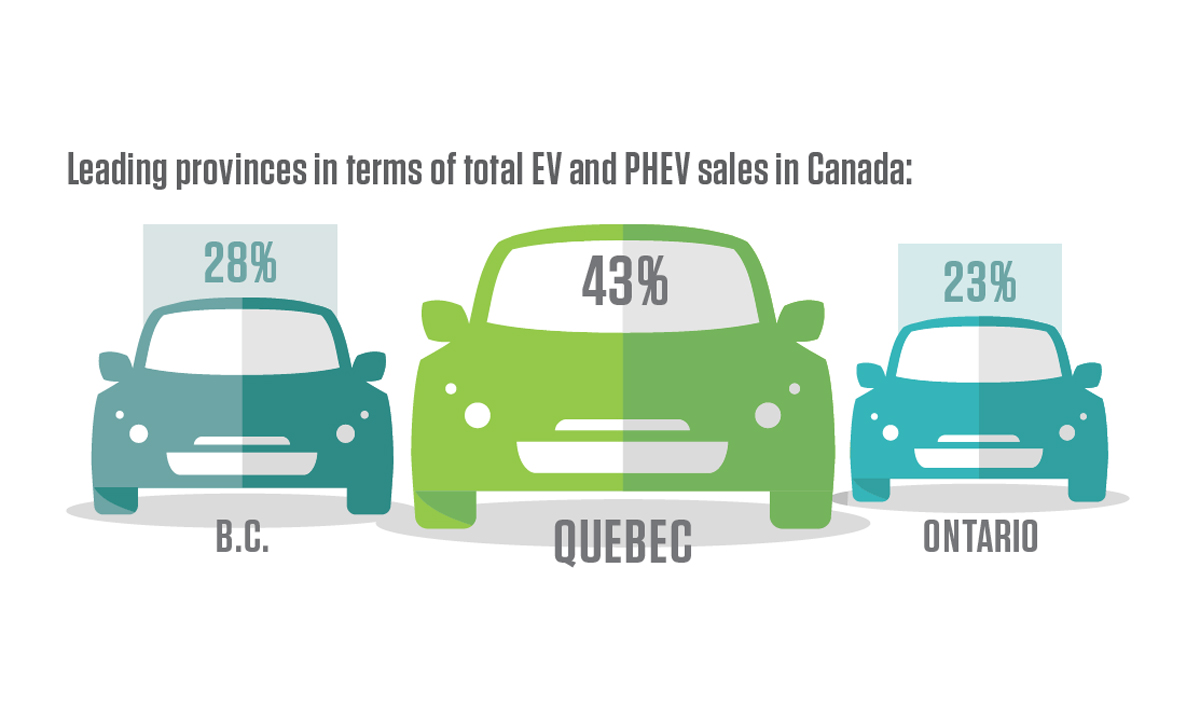A look at the sales numbers reveals some interesting trends to watch.
2021 was by no means a “normal” year for Canadian dealerships. With supply chain issues and varying COVID restrictions at different times of the year, it would have been just about impossible to predict how it would end for EVs.
Now that it’s over, however, it’s interesting to take a look at what happened in Canada on the EV front and see what it might mean for the future.
The first thing that jumps out when looking at IHS Markit’s 2021 EV and PHEV vehicle data is the continuous growth in sales year over year. All in all, throughout Canada EVs have seen a year over year growth in sales of 51 per cent while PHEVs have seen a 73 per cent year over year growth.
This extremely high year over year growth could be in part a result of some 2020 purchases being pushed back to 2021 for various reasons. However, in an industry which as a whole is currently in a downward cycle in terms of sales volume, such high growth percentages definitely stand out even if some circumstantial factors may be involved.
The three leading provinces in terms of total EV and PHEV sales in Canada are without surprise Quebec, B.C. and Ontario. Quebec has 43 per cent of all EV and PHEV registrations in Canada with B.C. and Ontario following with 28 per cent and 23 per cent respectively.
Does this mean that all the EV action for dealerships is happening in those three provinces only? Definitely not!
While Ontario has a large volume overall, it also has a much larger population and ultimately many more dealerships.
If one looks at the percentage of light vehicles sold that were EV or PHEV, the podium changes.
Canada-wide EV and PHEV sales now represent almost 4 per cent of the entire light duty vehicle market.
B.C. gets top spot with 13 per cent of all light vehicles sold that were EVs or PHEVs. Quebec comes in second spot with 9.5 per cent of all vehicles sold that were EVs or PHEVs. And in third place….. give yourself a major pat on the back if you guessed… Yukon Territories!
Yes, Yukon passed Ontario for 3rd place in 2021 with 4.5 per cent of all light duty vehicles sold being EVs or PHEV. Ontario’s 3.3 per cent left it outside of the podium.
I believe that this latest stat is proof that vehicle electrification is not just specific to Canada’s most populous provinces with large metropolitan areas. Dealers in all corners of the country are starting to see the share of EVs being sold increase.
Volume wise, obviously large metropolitan areas still lead the way with Vancouver registering an EV for about one in seven vehicles sold in 2021 and Montreal registering an EV or a PHEV for every nine light duty vehicles sold.
Interestingly, while Toronto saw a large increase in its year over year EV and PHEV sales, it still lags the leaders considerably with one in every 23 vehicles sold. Toronto was lagging even more in 2020 with just one in every 40 vehicles being an EV or PHEV back then.
It will be interesting to see if Toronto can claw back the four to six year gap it has with other major metro areas like Vancouver and Montreal. With improved EV charging initiatives both at the municipal level in the GTA and also some good province-wide initiatives from OPG and Hydro One, Toronto EV drivers are starting to have much better access to charging.
It will be interesting to see if this will be sufficient for the GTA to continue to grow its EV numbers at the current pace or if it will be stuck in 3rd place until the Ontario government follows the lead on B.C. and Quebec and incentivizes EV and PHEV purchases.
Canada-wide EV and PHEV sales now represent almost 4 per cent of the entire light duty vehicle market. From what I’ve seen in the last two years, there are two factors primarily responsible for this percentage not being at 10 per cent yet.
First is the short-term limited availability of models already offered to customers. It is clear that there is currently more demand than supply for existing models. This limits the number of drivers able to get their hands on an EV or PHEV in a given year.
Many buyers have ordered their EV and are waiting for it, and others couldn’t afford to wait and have thus pushed back their EV purchase to their “next” car and decided to opt for one last gas car this time around. Had the orders been available rapidly, EV and PHEV sales would likely represent a higher percentage of overall sales.
Second is the current lack of options in the pick-up truck and mid to large SUV category. Almost every major truck manufacturer has by now made some announcements on their upcoming EV truck model.
Once the EV pick-ups already announced become widely available and supply is also less constrained for other EV models, I expect the Canadian market to climb rapidly from the low double digit territory to the mid double digit territory in terms of per cent of EV and PHEV sales.





